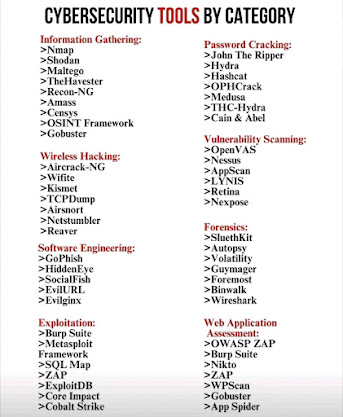Introduction
In today’s digital landscape, cybersecurity is a crucial field that demands continuous vigilance and expertise. Cybersecurity professionals, including penetration testers, Security Operations Center (SOC) analysts, and ethical hackers, rely on specialized tools to assess and enhance security postures. This article categorizes and explores essential cybersecurity tools used for various functions, including information gathering, password cracking, wireless hacking, vulnerability scanning, forensics, exploitation, and web application security. Mastering these tools is imperative for anyone looking to strengthen their cybersecurity skills and improve overall digital defense mechanisms.
Information Gathering
Effective cybersecurity begins with reconnaissance and intelligence gathering. These tools help security professionals collect information about targets, networks, and systems to identify potential vulnerabilities:
Nmap – A powerful network scanner that maps hosts and services, detecting open ports and security risks.
Password Cracking
Password security remains a critical challenge in cybersecurity. The following tools assist in testing and cracking passwords to assess system resilience:
John The Ripper – A popular password cracking tool used to detect weak credentials.
Shodan – A search engine that scans for exposed devices and systems on the internet.
Maltego – A visualization tool for OSINT (Open Source Intelligence) and link analysis.
TheHarvester – Gathers emails, subdomains, and metadata from public sources.
Recon-NG – A reconnaissance framework for automating data collection.
Amass – Used for DNS enumeration and mapping external networks.
Censys – A search engine for discovering internet-connected assets.
OSINT Framework – A collection of open-source intelligence tools.
Gobuster – A directory and subdomain brute-forcing tool.
Wireless Hacking
Securing wireless networks requires dedicated tools for monitoring and penetration testing:
Aircrack-NG – A suite of tools for assessing Wi-Fi security.
Wifite – Automates wireless auditing processes.
Kismet – Detects wireless networks and intrusion attempts.
TCPDump – A packet analyzer for network traffic inspection.
AirSnort – Recovers encryption keys from Wi-Fi traffic.
Hydra – A fast password-cracking tool supporting multiple protocols.
Hashcat – A powerful password recovery tool.
OPHCrack – Recovers Windows passwords using rainbow tables.
Medusa – A brute-force attack tool.
THC-Hydra – Another versatile network login cracker.
Cain & Abel – A password recovery tool for Windows.
Vulnerability Scanning
Identifying security weaknesses is essential for proactive defense. These tools help detect vulnerabilities in networks and applications:
OpenVAS – A comprehensive open-source vulnerability scanner.
Nessus – A widely used vulnerability assessment tool.
AppScan – Detects application security vulnerabilities.
LYNIS – A security auditing tool for Unix-based systems.
Retina – An enterprise-level vulnerability scanner.
Netstumbler – Detects and audits wireless networks.
Reaver – Cracks WPS-encrypted Wi-Fi networks.
Software Engineering
Security testing extends beyond infrastructure into software development. These tools aid in social engineering and phishing assessments:
GoPhish – A phishing simulation tool for security awareness training.
HiddenEye – A social engineering framework.
Nexpose – A risk-based vulnerability management solution.
Forensics
Digital forensics is vital for investigating cyber incidents and analyzing compromised systems. The following tools assist in forensic analysis:
SleuthKit – A collection of command-line tools for forensic analysis.
Autopsy – A user-friendly forensic suite based on SleuthKit.
Volatility – A memory forensics framework.
Guymager – A forensic disk imaging tool.
SocialFish – A phishing simulation tool.
EvilURL – Detects homograph attacks.
Evilginx – A man-in-the-middle attack framework for phishing.
Exploitation
Exploitation tools assist in testing security defenses by simulating real-world attacks:
Burp Suite – A comprehensive web security testing tool.
Metasploit Framework – A powerful tool for developing and executing exploits.
SQLMap – An automated SQL injection detection tool.
ZAP (OWASP ZAP) – A security scanner for web applications.
ExploitDB – A database of publicly available exploits.
Core Impact – A commercial penetration testing tool.
Cobalt Strike – A threat emulation platform.
Foremost – A file recovery and forensic analysis tool.
Binwalk – Analyzes and extracts files from firmware images.
Wireshark – A widely used network protocol analyzer.
Web Application Security
Securing web applications is crucial in mitigating cyber threats. These tools are widely used for web vulnerability assessment:
OWASP ZAP – A security scanner for detecting web vulnerabilities.
Burp Suite – A tool for web application security testing.
Nikto – A web server scanner that detects outdated software and vulnerabilities.
WPScan – A WordPress security scanner.
Gobuster – Used for brute-forcing directories and subdomains.
App Spider – A web application security scanner.
Conclusion
Cybersecurity professionals must continuously adapt to emerging threats by leveraging advanced tools and methodologies. The categorized tools listed above serve as essential assets for penetration testing, vulnerability scanning, forensic investigations, and web security assessments. By mastering these tools, cybersecurity practitioners can effectively safeguard systems, networks, and applications against evolving cyber threats. As the digital landscape advances, staying informed and proficient in these tools remains paramount for maintaining a robust security posture.










0 Comments